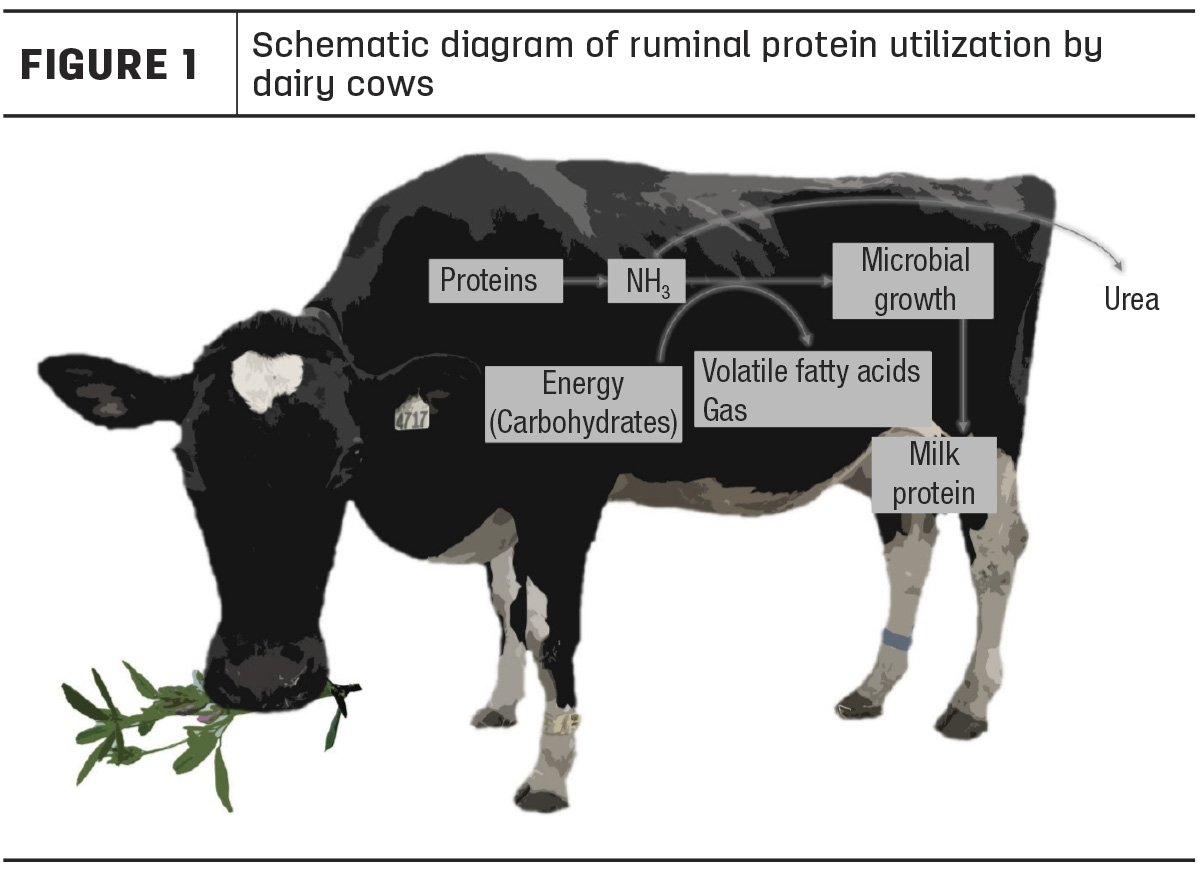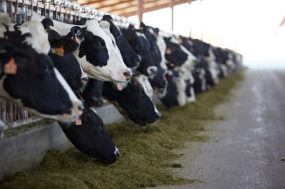To read this article in French, click here.
Rumen microorganisms need energy to use the protein contained in a cow’s ration and synthesize microbial proteins, which then can be used by the animal to produce milk, for example. When the supply of degradable proteins in the rumen is high, as is the case for alfalfa, and the readily available energy in the ration is insufficient, part of the forage’s nitrogen escapes microbial digestion and may be lost into the environment in the form of urea (Figure 1).

To minimize these nitrogen losses and ensure efficient conversion of feed proteins into microbial proteins, sufficient energy must be readily available – this is referred to as a good energy-to-protein balance. To verify this theory specifically in forages, in vitro incubations of alfalfa with higher and lower energy-to-protein ratios were carried out as part of a major research project funded by the Dairy Research Cluster 3 (Agriculture and Agri-Food Canada and Dairy Farmers of Canada under the AgriScience Program of the Canadian Agricultural Partnership). The purpose of these incubations was to simulate the fermentation and nutrient degradation processes that take place in the rumen. This trial confirmed that alfalfa forages with a better energy-to-protein ratio led to higher microbial protein synthesis and less ammonia (NH3) in the rumen fluid.
Now, how can the energy-to-protein balance of forages be improved? For several years now, we examined, with our colleagues, this question from a number of angles. For example, in addition to afternoon harvesting – which increases the concentration of sugars and starch in forages, two important sources of readily available energy – we have recently demonstrated that adding other legumes to alfalfa, such as red clover or birdsfoot trefoil, improves the energy-to-protein ratio of forage mixtures.
Our team has also conceived a genetic selection method aimed at developing an energy-rich alfalfa, which was used to create four successively "enhanced" populations. These populations were evaluated in a field trial at three sites in Canada (populations from one to three cycles of selection) and/or in a greenhouse trial (populations from one to four cycles of selection) and compared to a non-selected population (control). In the field trial, a gradual increase in energy concentrations was observed, up to 1.4% dry matter for the population from the third cycle of selection. In the greenhouse trial, an increase in energy of 4.6% dry matter was observed for the population from the fourth cycle of selection. By comparison, the scientific literature reports that an energy increase of 4% dry matter has beneficial effects on animal performance. The population from the fourth cycle of selection is therefore very promising.
Furthermore, since nutritive value is expressed as a percentage of dry matter, any change in one of its components, such as energy, inevitably impinges other components (Figure 2, white dot line). In this project, increasing the energy concentration of alfalfa led to a decrease in fibre concentration only, resulting in improved in vitro dry matter digestibility for populations from the third and fourth cycles of selection. As the crude protein concentration of the alfalfa was not affected, the energy-to-protein balance of these new populations was improved. It is also important to note that their annual yields were comparable to those of the control population.

Over the next few years, we plan to evaluate the protein use efficiency of dairy cows fed with this improved alfalfa following four cycles of genetic selection. We will continue our work, both in the laboratory and in the field, to develop an energy-rich alfalfa with the aim of reducing the environmental footprint of the queen of forage legumes.
This article was written by Mireille Thériault, Annie Claessens, Annick Bertrand and Solen Rocher with Agriculture and Agri-Food Canada, Quebec Research and Development Centre.
Dairy Farmers of Canada (DFC) invests in scientific research to foster innovation in the Canadian dairy sector. DFC supports research initiatives that benefit all Canadian dairy farmers and works in collaboration with its members and other sector partners to address priorities outlined in the National Dairy Research Strategy. The goals of this strategy are to increase farm efficiency and sustainability, enhance animal health, care and welfare practices, and strengthen the role of dairy in human nutrition and health, as well as in sustainable diets. Visit DFC Dairy Research for more information.








